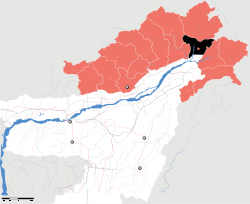Lower Dibang Valley district
| Lower Dibang Valley district | |
|---|---|
| District of Arunachal Pradesh | |
 Location of Lower Dibang Valley district in Arunachal Pradesh | |
| Country | India |
| State | Arunachal Pradesh |
| Headquarters | Roing |
| Population (2011) | |
| • Total | 53,986[1] |
| Demographics | |
| • Literacy | 70.4%[1] |
| • Sex ratio | 919[1] |
The Lower Dibang Valley district (Pron:/dɪˈbæŋ/) is an administrative district in the state of Arunachal Pradesh in northeastern India. It is the tenth least populous district in the country (out of 640).[2]
History
The area of the present district was an integral part of the Sutiya Kingdom from the 12th to the 16th century. In June 1980, Dibang Valley district was created out of part of Lohit district.[3] On 16 December 2001, Dibang Valley district was bifurcated into Dibang Valley district and Lower Dibang Valley district.[3]
Geography
The district headquarters of the district is Roing. Before it was carved out on 16 December 2001, Anini was the district headquarters.[4]
Transport
The 2,000-kilometre-long (1,200 mi) proposed Mago-Thingbu to Vijaynagar Arunachal Pradesh Frontier Highway along the McMahon Line,[5][6][7][8] (will intersect with the proposed East-West Industrial Corridor Highway) and will pass through this district, alignment map of which can be seen here and here.[9]
Divisions
There are two Arunachal Pradesh Legislative Assembly constituencies located in this district: Dambuk and Roing. Both are part of Arunachal East Lok Sabha constituency.[10]
Demographics
According to the 2011 census Lower Dibang Valley district has a population of 53,986,[1] roughly equal to the nation of Saint Kitts and Nevis.[11] This gives it a ranking of 630th in India (out of a total of 640).[1] The district has a population density of 14 inhabitants per square kilometre (36/sq mi) .[1] Its population growth rate over the decade 2001–2011 was 7.01%.[1] Lower Dibang Valley has a sex ratio of 919 females for every 1000 males,[1] and a literacy rate of 70.38%.[1]
Languages
Languages spoken include Idu Mishmi and Adi, an endangered Sino-Tibetan tongue .[12]
Flora and fauna
The district is rich in wildlife. Rare mammals such as Mishmi takin, red goral, elephant, wild water buffalo and leaf muntjac occur while among birds there is the rare Sclater's monal, Blyth's tragopan, rufous-necked hornbill, Bengal florican, white-winged wood duck.[13] A flying squirrel, new to science, i.e., Mishmi Hills giant flying squirrel (Petaurista mishmiensis) also occurs in this district.[14]
In 1980 Lower Dibang Valley district became home to the Mehao Wildlife Sanctuary, which has an area of 282 km2 (108.9 sq mi).[15]
References
- 1 2 3 4 5 6 7 8 9 "District Census 2011". Census2011.co.in.
- ↑ "District Census 2011". Census2011.co.in. 2011. Retrieved 2011-09-30.
- 1 2 Law, Gwillim (25 September 2001). "Districts of India". Statoids. Retrieved 2011-10-11.
- ↑ Official Website of the Lower Dibang Valley District
- ↑ "Top officials to meet to expedite road building along China border". Dipak Kumar Dash. timesofindia.indiatimes.com. Retrieved 27 October 2014.
- ↑ "Narendra Modi government to provide funds for restoration of damaged highways". http://www.dnaindia.com. Retrieved 27 October 2014. External link in
|publisher=(help) - ↑ "Indian Government Plans Highway Along Disputed China Border". Ankit Panda. thediplomat.com. Retrieved 27 October 2014.
- ↑ "Govt planning road along McMohan line in Arunachal Pradesh: Kiren Rijiju". Live Mint. Retrieved 2014-10-26.
- ↑ "China warns India against paving road in Arunachal". Ajay Banerjee. tribuneindia.com. Retrieved 2014-10-26.
- ↑ "Assembly Constituencies allocation w.r.t District and Parliamentary Constituencies". Chief Electoral Officer, Arunachal Pradesh website. Retrieved 21 March 2011.
- ↑ US Directorate of Intelligence. "Country Comparison:Population". Retrieved 2011-10-01.
Saint Kitts and Nevis 50,314 July 2011 est.
- ↑ M. Paul Lewis, ed. (2009). "Galo: A language of India". Ethnologue: Languages of the World (16th ed.). Dallas, Texas: SIL International. Retrieved 2011-09-28.
- ↑ Choudhury, Anwaruddin (2008) Survey of mammals and birds in Dihang-Dibang biosphere reserve, Arunachal Pradesh. Final report to Ministry of Environment & Forests, Government of India. The Rhino Foundation for nature in NE India, Guwahati, India. 70pp.
- ↑ Choudhury,Anwaruddin (2009).One more new flying squirrel of the genus Petaurista Link, 1795 from Arunachal Pradesh in north-east India. The Newsletter and Journal of the RhinoFoundation for nat. in NE India 8: 26–34, plates.
- ↑ Indian Ministry of Forests and Environment. "Protected areas: Arunachal Pradesh". Retrieved 25 September 2011.
External links
 |
Upper Siang district | Upper Dibang Valley district | |
 |
| East Siang district | |
Lohit district | ||
| ||||
| | ||||
| Tinsukia district, Assam |
Coordinates: 28°08′40″N 95°50′30″E / 28.144545°N 95.841722°E